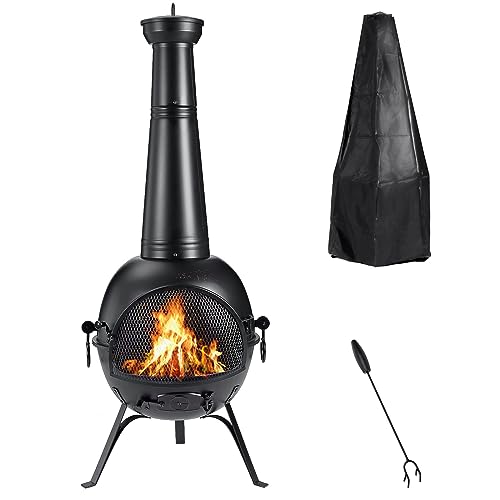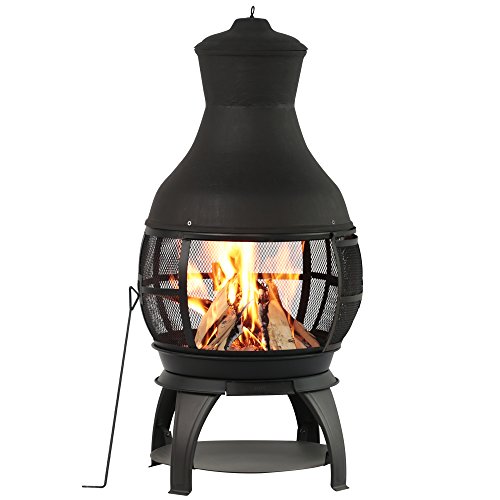The 9 Things Your Parents Teach You About Chiminea Terracotta
페이지 정보

본문
 A Chiminea Terracotta Adds Warmth and Ambiance to Your Backyard Patio
A Chiminea Terracotta Adds Warmth and Ambiance to Your Backyard PatioA chiminea will provide warmth and charm to your backyard. The chimney directing the smoke upwards, thus preventing sparks and flames from damaging nearby plants or igniting a deck or home.
Clay chimineas should be broken up slowly. The first few fires should be relatively small and slow-burning. The sealing of a chiminea is recommended, particularly in rainy climates.
Material
Chiminesas can add warmth and character to any patio. The classic pot-belly style is perfect for entertaining, but modern designs now suit a wide range of styles of decor. While clay is the most popular material, chimineas can also be available in cast iron and aluminum. Each material type has its distinct advantages. While clay is simple to maintain, metal is more durable and better able to withstand high temperatures.
Take into consideration the design, size and type of fuel when choosing the right Chiminea. Its size should be able to accommodate the amount of wood you'll use to ensure it's burning at a steady flame. The larger models are more suitable for large gatherings while smaller models work better in intimate settings. A chimney is a vent that directs smoke upwards and protects the area from rain and preventing it from being blown around by strong winds.
The design of the chiminea is distinct from other fire pits for outdoor use. The bowl-shaped base holds the flames and protects the flames from rain, wind and debris. The chimney adds a decorative appearance and makes it easy to control the size of the flames.
Chimineas made of clay can be formed by hand, and then fired at high temperatures. They're often coated with ceramic glaze to create a beautiful and durable object to weather damage. Some are decorated in Mexican-inspired patterns. These chimineas can be purchased in the garden stores and home improvement centers.
Before lighting a chiminea, it is recommended that you must cover its interior with coarse-grained gravel or sand. The sand helps reduce smoke and also prevents the clay from cracking after being fired. Once you've covered your base, you can place small pieces of kindling at the center. Use a natural lighter such as this one from Amazon, to help with lighting.
Use a spatula or fork with a long handle to turn the hot embers when you're ready. Cooking food should not be done directly on active flames as it could cause burning and blacken the food beyond recognition. Begin with a small flame and build it up slowly. Then, move the cooking pan to the top rated chiminea of the smoke stack.
Design
A chiminea is a fire pit that looks a bit like a wide-bottomed potbelly stove, with a mouth for the fire and a long narrow chimney to smoke. The chimney also protects the fire from rain and wind and can also extinguish a more open fire pit. Since more than 400 years Chimineas have been used to cook for gatherings and cooking as well as heating homes. Originally handmade of clay, they're now available in cast iron or terracotta, with both traditional and modern styles.
Modern chimneys are often free of the curves of traditional models, they still retain a distinctive chimney design. They come in a variety of shapes and sizes. They range from 12 to 16 inches diameter at the base and 25 to 30 inch high (including the stand). The chimney is usually about 6 feet.
The size of a chiminea's height is crucial because it helps direct smoke upwards, which can stop it from blowing into objects and people in your yard or house. You can also make use of aromatic woods that make a wonderful aroma as they burn. This can enhance the experience.
When selecting a chiminea you want to purchase, make sure it is made of durable materials that can withstand extreme heat. Beware of models that have decorative elements or other features that could break or crack when heated. If you choose a clay or terracotta chiminea that is not seasoned, it should be by burning small amounts of wood for 3 to 4 hours until the clay is able to become cured. The chiminea should be covered with a lid when not in use to prevent water from leaking over the flames and burning it.
Cast iron chimineas are able to withstand higher temperatures and rougher treatment because they are heavier and more durable than clay models. They also offer more versatility, as they can burn briquettes or coal in addition to wood. If you're looking for an elegant design, go with an chiminea made of clay.
Whatever material you choose, make sure to place your chiminea in a safe distance from your house and any outdoor furniture. The chiminea outdoor fireplace should also be at least 10 feet away from any other structures, like a fence or shed. Create a hearth for your patio by placing pavers across a small space to serve as a platform for your chiminea and make it easier to control the fire.
Installation
Chimineas are a focal point for any family gathering and adds an additional dimension to outdoor spaces. But like any fire pit or fireplace it is crucial to be aware of the maintenance requirements before you purchase one. Traditional clay chimineas tend to be more fragile than cast iron chimineas but both can endure the elements, but the different designs and materials need a different approach to care.
Make the base of the chiminea large before. The bottom should be covered with sand, gravel, or lava rock to keep it from direct contact with the fire. This will reduce smoke and keep the chiminea from cracking.
It is also important to ensure that the chiminea is placed on the ground in a secure and safe location. Never place it on decks or any other surfaces that are flammable. If you have to place it on a flammable area, use a metal grates to raise the wood. This will shield the chiminea from the sparks and heat of the fire.
Before lighting the chiminea for the first time, it needs to be seasoned by burning several small fires in it. This will prevent the chiminea from cracking when you burn lots of wood.
After each fire Clean the chiminea thoroughly by rubbing it with a wire-bristle brush or a cloth. It is also important to remove any ash and creosote inside the chiminea. These chemicals will alter the quality and quantity of fires you can have in your chiminea if they are not removed.
The chiminea must be sealed with a protective cover when it is not being used. This will prevent the clay from becoming wet and cracking or shrinking. If exposed to snow or rain Chimineas may suffer this kind of damage.
Even in summer, it is best to cover the chiminea. It is also recommended to have a backup source of fuel for the fire, such as a propane tank or wood. It is also a good idea to keep a nearby fire extinguisher to put out any sudden blazes.
Maintenance
To ensure that chimineas last as long as they can, they require regular maintenance. This includes cleaning the structure as well as applying protective coatings and properly storing it during the off-season to protect against extreme temperatures. Taking these measures and following the guidelines for basic usage will increase the life of your chiminea and decrease potential safety hazards.
Chimineas, which are composed of clay, may break if exposed to sudden temperature fluctuations. This is the reason it's essential to keep your terra cotta in a safe and dry place during the off-season, preferring an enclosure that protects against rain and frost. You should also regularly apply an adhesive on your clay fireplace to shield it from the effects of moisture and temperature changes.
When cleaning a chiminea, it is important to use non-abrasive materials and a soft brush or cloth to avoid damaging the clay surface. After you've scrubbed the surface, wash it off using a bucket or hose. Give the chiminea time to completely dry before re-using it. This will prevent the growth of mold and mildew and will keep the top rated chiminea looking brand new.
If there is a crack on your chiminea it is essential to secure the pieces together. Then, apply outdoor oven cement over the crack. You can purchase this from many hardware stores. It needs to be applied with a spatula or pointing trowel. You must allow the cement to completely dry before lighting a test fire in the chiminea.
After the cement has dried, apply medium-fine sandpaper on the affected area to prepare it for painting. Then, you can paint it with a household or masonry paint in a color that matches your chiminea. If the chiminea has corrosion or rust on it remove it by sanding the affected areas, then washing them with water to rid them of any dirt or dust particles.

- 이전글Looking For Inspiration? Check Out Audi Car Key 24.10.21
- 다음글What Is Vibrating Panty Sex Toy And Why Is Everyone Talking About It? 24.10.21
댓글목록
등록된 댓글이 없습니다.


